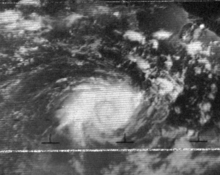ESSA-8 (original) (raw)
From Wikipedia, the free encyclopedia
ESSA-8
 |
|
|---|---|
| Mission type | Weather satellite |
| Operator | ESSA/NASA[1] |
| COSPAR ID | 1968-114A |
| SATCAT no. | 3615 |
| Spacecraft properties | |
| Manufacturer | RCA Astro |
| Launch mass | 297 kilograms (655 lb)[2] |
| Start of mission | |
| Launch date | December 15, 1968, 17:21:04 (1968-12-15UTC17:21:04Z) UTC[3] |
| Rocket | Delta N |
| Launch site | Vandenberg SLC-2E |
| End of mission | |
| Disposal | Decommissioned |
| Deactivated | March 12, 1976 (1976-03-13) |
| Orbital parameters | |
| Reference system | Geocentric |
| Regime | Low Earth |
| Semi-major axis | 7,816.70 kilometers (4,857.07 mi) |
| Eccentricity | 0.0031481 |
| Perigee altitude | 1,421 kilometers (883 mi) |
| Apogee altitude | 1,470 kilometers (910 mi) |
| Inclination | 101.31 degrees |
| Period | 114.63 minutes |
| Epoch | December 7, 2013, 13:01:30 UTC[4] |
| TOS← ESSA-7ESSA-9 → |
ESSA-8 was a weather satellite launched by the National Aeronautics and Space Administration (NASA) on December 15, 1968, from Vandenberg Air Force Base, California. Its name was derived from that of its oversight agency, the Environmental Science Services Administration (ESSA).
ESSA-8 was an 18-sided polygon. It measured 42 inches (110 cm) in diameter by 22 inches (56 cm) in height, with a mass of 130 kilograms (290 lb). It was made of aluminum alloy and stainless steel covered with 10,020 solar cells. The cells charged 63 nickel–cadmium batteries, which served as a power source. The satellite could take 8 to 10 pictures every 24 hours. Each photo covered a 2,000-square-mile (5,200 km2) area at a resolution of 2 miles (3.2 km) per pixel.
A picture taken by the ESSA-8 satellite that shows Cyclone Tracy on December 25, 1974
ESSA-8's mission was to replace ESSA-6, and provide detailed cloud pattern photography to ground stations worldwide. Partners in the project included NASA, ESSA, RCA, the National Weather Service, and the National Centers for Environmental Prediction (NMC).
ESSA-8 operated for 2,644 days until it was deactivated on March 12, 1976.
- ^ "ESSA". NASA Science. Archived from the original on December 11, 2013. Retrieved December 8, 2013.
- ^ "ESSA 8". National Space Science Data Center. Retrieved December 8, 2013.
- ^ McDowell, Jonathan. "Launch Log". Jonathan's Space Page. Retrieved December 8, 2013.
- ^ "ESSA 8 (TOS-F) Satellite details 1968-114A NORAD 3615". N2YO. December 7, 2013. Retrieved December 8, 2013.
